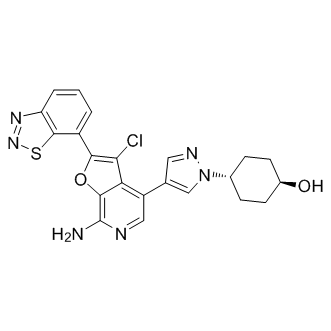| Cas No.: | 1137868-52-0 |
| Chemical Name: | 4-[(9-cyclopentyl-7,7-difluoro-5-methyl-6-oxo-8H-pyrimido[4,5-b][1,4]diazepin-2-yl)amino]-2-fluoro-5-methoxy-N-(1-methylpiperidin-4-yl)benzamide |
| Synonyms: | TAK 960,TAK960 |
| SMILES: | CN1CCC(CC1)NC(=O)C2=CC(=C(C=C2F)NC3=NC=C4C(=N3)N(CC(C(=O)N4C)(F)F)C5CCCC5)OC |
| Formula: | C27H34F3N7O3 |
| M.Wt: | 561.6 |
| Sotrage: | 2 years -20°C Powder, 2 weeks 4°C in DMSO, 6 months -80°C in DMSO |
| Description: | TAK-960 is an orally available, selective inhibitor of polo-like kinase 1 (PLK1), with an IC50 of 0.8 nM at 10 μM ATP; TAK-960 also shows inhibitory activities against PLK2 and PLK3, with IC50s of 16.9 and 50.2 nM, respectively. |
| In Vivo: | TAK-960 (7.5 mg/kg, p.o.) shows a significant increase in median survival compared with vehicle in MV4-11 human leukemia model. TAK-960 (10 mg/kg, p.o.) inhibits tumor growth in the MDR1-expressing K562ADR-bearing leukemia xenograft model[1]. TAK-960 (10 mg/kg) significantly suppresses tumor growth when combined with IR in tumor xenografts[2]. |
| In Vitro: | TAK-960 inhibits full-length PLK1 protein with IC50 of 0.8 nM, wich is 20-fold lower than the next lowest IC50 value (PLK2: 16.9 nM). TAK-960 (2-1000 nM) causes accumulation of G2-M cells in HT-29 cells. TAK-960 inhibits proliferation of multiple cancer cell lines, with mean EC50 values ranging from 8.4 to 46.9 nM, but not in nondividing normal cells[1]. TAK-960 (8 nM) leads to G2/M cell cycle arrest without significant cytotoxicity in HeLa cells. TAK-960 does not sensitize cancer cells to radiation when an insufficient amount of time is provided to induce mitotic arrest. The overexpression of a PLK1 mutant, PLK1-R136G&T210D, which is confirmed to cancel the TAK-960-mediated increase in the proportion of mitotic cells, abrogates the radiosensitizing effects of TAK-960[2]. |

 DC Chemicals' products qualify for U.S. tariff exemptions. We guarantee no price increases due to customs duties and maintain stable supply, continuing to deliver reliable research solutions to our American clients.
DC Chemicals' products qualify for U.S. tariff exemptions. We guarantee no price increases due to customs duties and maintain stable supply, continuing to deliver reliable research solutions to our American clients.





















